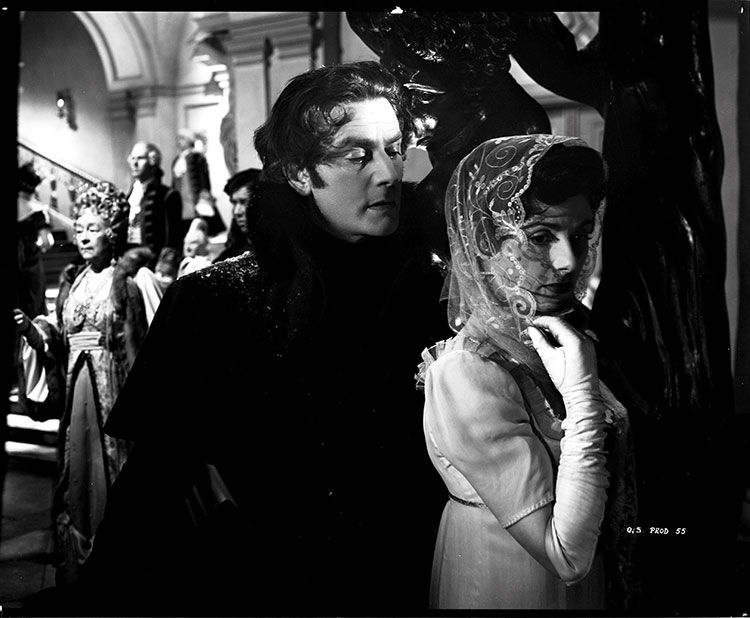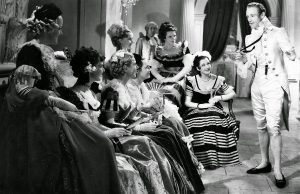The Queen of Spaces (1949)

Toronto Film Society presented The Queen of Spades (1949) on Monday, October 30, 2017 in a double bill with The Medium as part of the Season 70 Monday Evening Film Buff Series, Programme 2.
Production Company: De Grunwald Productions, Associated British Picture Corporation (ABPC). Producer: Anatole de Grunwald. Director: Thorold Dickinson. Screenplay: Rodney Ackland and Arthur Boys, based on the short story by Alexander Pushkin. Cinematography: Otto Heller. Music: Georges Auric. Film Editor: Hazel Wilkinson. Costume Design: Oliver Messel. Art Direction: William Kellner. Release Date: April 11, 1949.
Cast: Anton Walbrook (Capt. Herman Suvorin), Edith Evans (The Old Countess Ranevskaya), Yvonne Mitchell (Lizaveta Ivanova), Ronald Howard (Andrei), Mary Jerrold (Old Varvarushka), Anthony Dawson (Fyodor), Miles Malleson (Tchybukin), Michael Medwin (Hovaisky), Athene Seyler (Princess Ivashin), Ivor Barnard (Bookseller), Maroussia Dimitrevitch (Gypsy Singer), Violetta Elvin (Gypsy Dancer), Pauline Tennant (Young Countess), Jacqueline Clarke (Milliner’s Assistant).
Thorold Dickinson (November 16, 1903-April 14, 1984) has been called the “major lost talent of the British film industry.” Nevertheless, four of his films, Gaslight (1940), The Next of Kin (1942), Men of Two Worlds (1946) and The Queen of Spades (1949) are among the most critically respected British films of all time. Although he directed only nine feature films and a handful of short documentaries, he devoted his life to the advancement of cinema. After his directorial career ended, he became Chief of Film Services of the U.N. Department of Public Information in New York and later returned to England to establish the first department of film studies in a British university. His adventurous and truly global involvement in film took him to Paris in the heyday of silent cinema in the 1920s, to Stalin’s USSR in 1937, to the Spanish Civil War, to Africa, India, Israel and America.
Producer of the film, Anatole de Grunwald, was born in Russia but grew up in England and did most of his film work in his adopted country. Although The Queen of Spades is set in Russia, it has an all-British cast, and the film has the feel of a screen adaptation of a classic English novel set in the mansions and taverns of London. If it were not for the strange Russian names of the characters and the mention of vodka from time to time, no viewer would realize that the film is actually taking place in 19th century St. Petersburg. However, the setting of the tale is not one of the film’s critical aspects and that small point aside, The Queen of Spades is one of the best British films of the supernatural, in the same class as the much more famous Dead of Night, released just four years earlier.
Given that The Queen of Spades runs over 90 minutes and is based upon a short story, it is surprising how close an adaptation the film version is, with very few scenes added to extend the film’s running time to that of a full-length feature. There is no obvious padding in the movie, with the only significant detours from the main story line arising from the scenes in a gypsy tavern and a dance by one of the gypsy girls. The principal difference in the main plot between the two versions comes in flashback scenes early in the film where Hermann (played by Anton Walbrook) learns the backstory of how the Countess acquires the secret of the three winning cards which is somewhat different in the novella. In the end, The Queen of Spades commences with a story that is firmly rooted in the supernatural but ends with a tale that could be one of mysticism or could be one of madness. The film is actually more of an enigma than Pushkin’s short story.
There have been many other film versions of Pushkin’s “The Queen of Spades,” including several from France and Russia. In addition, an opera based upon “The Queen of Spades,” composed by Peter Illyich Tchaikovsky, premiered in St. Petersburg, Russia, in 1890 and has been performed many times since. It is still probably the most famous adaptation of Pushkin’s short story about Hermann and the secret of the three winning cards.
Sources: Thorold Dickinson and the British Cinema by Jeffrey Richards (1997), Thorold Dickinson: a world of film by Philip Horne and Peter Swaaab (2008) and Classic Horror Films and the Literature That Inspired Them by Ron Backer (2015)
Introduction by Caren Feldman
Reviews:
“Set in 1806, a bizarrely-mounted adaptation of Alexander Pushkin’s story of a Russian officer obsessed with learning the secret of winning at cards. He should have taken up Solitaire.” – Barry Chapman
“Exquisite production of an unusual, macabre Alexander Pushkin story about an impoverished Russian officer (Walbrook, in a rich performance) who will do anything to learn the mystical secret of winning at cards, known only by an imperious old woman. Brilliant use of chiaroscuro lighting and atmosphere in this British sleeper set in 1806.” – Leonard Maltin
Fun Facts:
The snow was actually made of shredded-up windows from German warplanes. Although it looked great onscreen, it was actually extremely uncomfortable for cast and crew alike.
Thorold Dickinson joined the production at the personal request of Anton Walbrook. Dickinson read the original Alexander Pushkin story on a Tuesday; read the script on Wednesday; and was in the studio by Saturday.
The studio was right beside a train line and very badly soundproofed. They had to post a man on the studio roof to watch out for trains so that filming could be suspended while the trains went past.
The card game being played is based on a version of Faro. Thorold Dickinson’s wife, Joanne, went to Harrod’s in London and bought a book on card games. A simple interpretation was used in the filming of the parlour scenes.
Notes complied by David Burgess












Leave a Reply